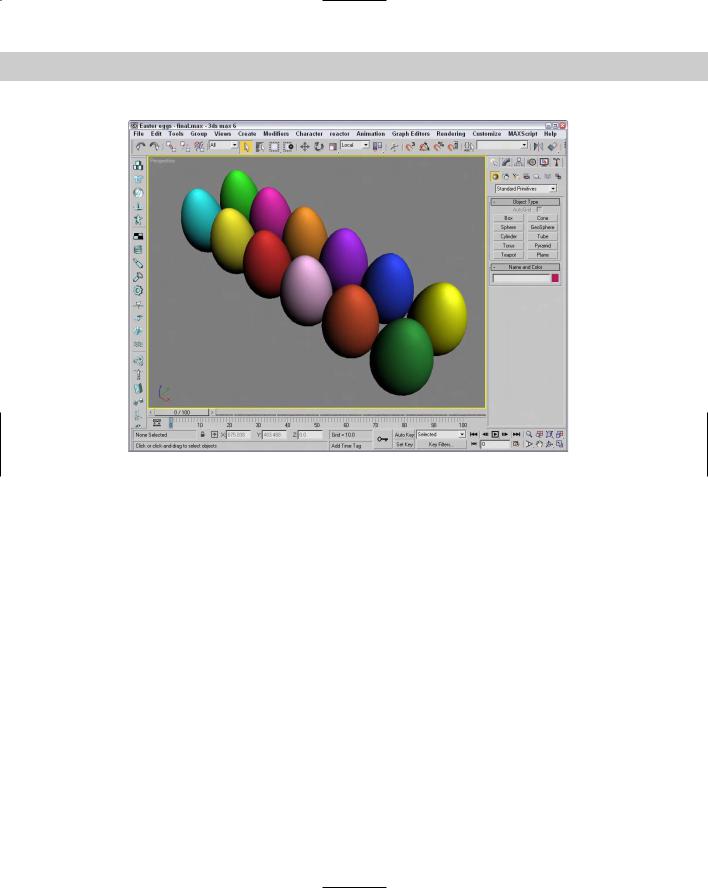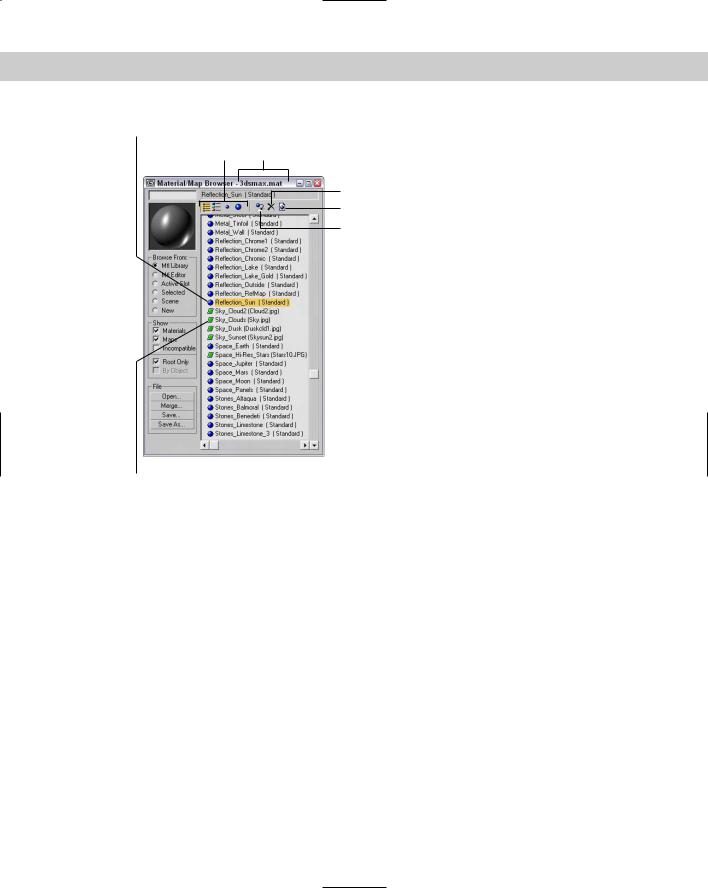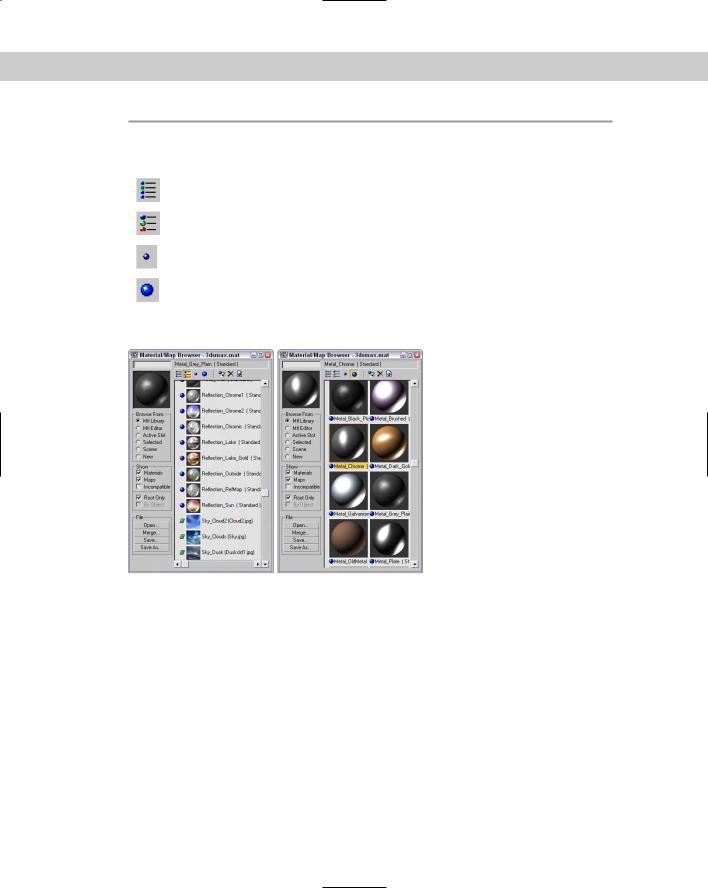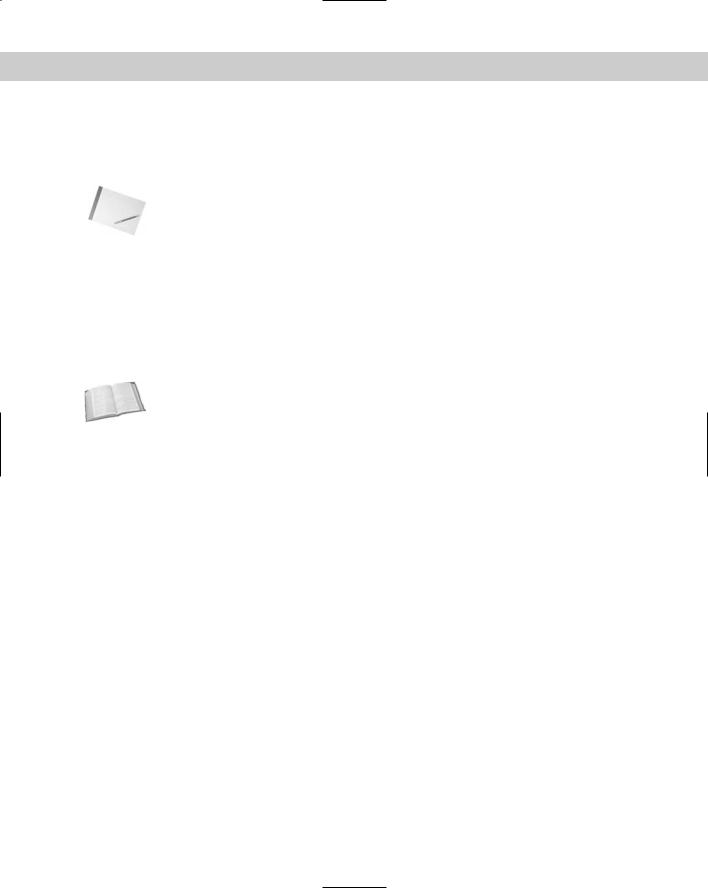
- •Preface
- •About This Book
- •Acknowledgments
- •Contents at a Glance
- •Contents
- •Relaxing at the Beach
- •Dressing the Scene
- •Animating Motion
- •Rendering the Final Animation
- •Summary
- •The Interface Elements
- •Using the Menus
- •Using the Toolbars
- •Using the Viewports
- •Using the Command Panel
- •Using the Lower Interface Bar Controls
- •Interacting with the Interface
- •Getting Help
- •Summary
- •Understanding 3D Space
- •Using the Viewport Navigation Controls
- •Configuring the Viewports
- •Working with Viewport Backgrounds
- •Summary
- •Working with Max Scene Files
- •Setting File Preferences
- •Importing and Exporting
- •Referencing External Objects
- •Using the File Utilities
- •Accessing File Information
- •Summary
- •Customizing Modify and Utility Panel Buttons
- •Working with Custom Interfaces
- •Configuring Paths
- •Selecting System Units
- •Setting Preferences
- •Summary
- •Creating Primitive Objects
- •Exploring the Primitive Object Types
- •Summary
- •Selecting Objects
- •Setting Object Properties
- •Hiding and Freezing Objects
- •Using Layers
- •Summary
- •Cloning Objects
- •Understanding Cloning Options
- •Mirroring Objects
- •Cloning over Time
- •Spacing Cloned Objects
- •Creating Arrays of Objects
- •Summary
- •Working with Groups
- •Building Assemblies
- •Building Links between Objects
- •Displaying Links and Hierarchies
- •Working with Linked Objects
- •Summary
- •Using the Schematic View Window
- •Working with Hierarchies
- •Setting Schematic View Preferences
- •Using List Views
- •Summary
- •Working with the Transformation Tools
- •Using Pivot Points
- •Using the Align Commands
- •Using Grids
- •Using Snap Options
- •Summary
- •Exploring the Modifier Stack
- •Exploring Modifier Types
- •Summary
- •Exploring the Modeling Types
- •Working with Subobjects
- •Modeling Helpers
- •Summary
- •Drawing in 2D
- •Editing Splines
- •Using Spline Modifiers
- •Summary
- •Creating Editable Mesh and Poly Objects
- •Editing Mesh Objects
- •Editing Poly Objects
- •Using Mesh Editing Modifiers
- •Summary
- •Introducing Patch Grids
- •Editing Patches
- •Using Modifiers on Patch Objects
- •Summary
- •Creating NURBS Curves and Surfaces
- •Editing NURBS
- •Working with NURBS
- •Summary
- •Morphing Objects
- •Creating Conform Objects
- •Creating a ShapeMerge Object
- •Creating a Terrain Object
- •Using the Mesher Object
- •Working with BlobMesh Objects
- •Creating a Scatter Object
- •Creating Connect Objects
- •Modeling with Boolean Objects
- •Creating a Loft Object
- •Summary
- •Understanding the Various Particle Systems
- •Creating a Particle System
- •Using the Spray and Snow Particle Systems
- •Using the Super Spray Particle System
- •Using the Blizzard Particle System
- •Using the PArray Particle System
- •Using the PCloud Particle System
- •Using Particle System Maps
- •Controlling Particles with Particle Flow
- •Summary
- •Understanding Material Properties
- •Working with the Material Editor
- •Using the Material/Map Browser
- •Using the Material/Map Navigator
- •Summary
- •Using the Standard Material
- •Using Shading Types
- •Accessing Other Parameters
- •Using External Tools
- •Summary
- •Using Compound Materials
- •Using Raytrace Materials
- •Using the Matte/Shadow Material
- •Using the DirectX 9 Shader
- •Applying Multiple Materials
- •Material Modifiers
- •Summary
- •Understanding Maps
- •Understanding Material Map Types
- •Using the Maps Rollout
- •Using the Map Path Utility
- •Using Map Instances
- •Summary
- •Mapping Modifiers
- •Using the Unwrap UVW modifier
- •Summary
- •Working with Cameras
- •Setting Camera Parameters
- •Summary
- •Using the Camera Tracker Utility
- •Summary
- •Using Multi-Pass Cameras
- •Creating Multi-Pass Camera Effects
- •Summary
- •Understanding the Basics of Lighting
- •Getting to Know the Light Types
- •Creating and Positioning Light Objects
- •Viewing a Scene from a Light
- •Altering Light Parameters
- •Working with Photometric Lights
- •Using the Sunlight and Daylight Systems
- •Using Volume Lights
- •Summary
- •Selecting Advanced Lighting
- •Using Local Advanced Lighting Settings
- •Tutorial: Excluding objects from light tracing
- •Summary
- •Understanding Radiosity
- •Using Local and Global Advanced Lighting Settings
- •Working with Advanced Lighting Materials
- •Using Lighting Analysis
- •Summary
- •Using the Time Controls
- •Working with Keys
- •Using the Track Bar
- •Viewing and Editing Key Values
- •Using the Motion Panel
- •Using Ghosting
- •Animating Objects
- •Working with Previews
- •Wiring Parameters
- •Animation Modifiers
- •Summary
- •Understanding Controller Types
- •Assigning Controllers
- •Setting Default Controllers
- •Examining the Various Controllers
- •Summary
- •Working with Expressions in Spinners
- •Understanding the Expression Controller Interface
- •Understanding Expression Elements
- •Using Expression Controllers
- •Summary
- •Learning the Track View Interface
- •Working with Keys
- •Editing Time
- •Editing Curves
- •Filtering Tracks
- •Working with Controllers
- •Synchronizing to a Sound Track
- •Summary
- •Understanding Your Character
- •Building Bodies
- •Summary
- •Building a Bones System
- •Using the Bone Tools
- •Using the Skin Modifier
- •Summary
- •Creating Characters
- •Working with Characters
- •Using Character Animation Techniques
- •Summary
- •Forward versus Inverse Kinematics
- •Creating an Inverse Kinematics System
- •Using the Various Inverse Kinematics Methods
- •Summary
- •Creating and Binding Space Warps
- •Understanding Space Warp Types
- •Combining Particle Systems with Space Warps
- •Summary
- •Understanding Dynamics
- •Using Dynamic Objects
- •Defining Dynamic Material Properties
- •Using Dynamic Space Warps
- •Using the Dynamics Utility
- •Using the Flex Modifier
- •Summary
- •Using reactor
- •Using reactor Collections
- •Creating reactor Objects
- •Calculating and Previewing a Simulation
- •Constraining Objects
- •reactor Troubleshooting
- •Summary
- •Understanding the Max Renderers
- •Previewing with ActiveShade
- •Render Parameters
- •Rendering Preferences
- •Creating VUE Files
- •Using the Rendered Frame Window
- •Using the RAM Player
- •Reviewing the Render Types
- •Using Command-Line Rendering
- •Creating Panoramic Images
- •Getting Printer Help
- •Creating an Environment
- •Summary
- •Creating Atmospheric Effects
- •Using the Fire Effect
- •Using the Fog Effect
- •Summary
- •Using Render Elements
- •Adding Render Effects
- •Creating Lens Effects
- •Using Other Render Effects
- •Summary
- •Using Raytrace Materials
- •Using a Raytrace Map
- •Enabling mental ray
- •Summary
- •Understanding Network Rendering
- •Network Requirements
- •Setting up a Network Rendering System
- •Starting the Network Rendering System
- •Configuring the Network Manager and Servers
- •Logging Errors
- •Using the Monitor
- •Setting up Batch Rendering
- •Summary
- •Compositing with Photoshop
- •Video Editing with Premiere
- •Video Compositing with After Effects
- •Introducing Combustion
- •Using Other Compositing Solutions
- •Summary
- •Completing Post-Production with the Video Post Interface
- •Working with Sequences
- •Adding and Editing Events
- •Working with Ranges
- •Working with Lens Effects Filters
- •Summary
- •What Is MAXScript?
- •MAXScript Tools
- •Setting MAXScript Preferences
- •Types of Scripts
- •Writing Your Own MAXScripts
- •Learning the Visual MAXScript Editor Interface
- •Laying Out a Rollout
- •Summary
- •Working with Plug-Ins
- •Locating Plug-Ins
- •Summary
- •Low-Res Modeling
- •Using Channels
- •Using Vertex Colors
- •Rendering to a Texture
- •Summary
- •Max and Architecture
- •Using AEC Objects
- •Using Architectural materials
- •Summary
- •Tutorial: Creating Icy Geometry with BlobMesh
- •Tutorial: Using Caustic Photons to Create a Disco Ball
- •Summary
- •mental ray Rendering System
- •Particle Flow
- •reactor 2.0
- •Schematic View
- •BlobMesh
- •Spline and Patch Features
- •Import and Export
- •Shell Modifier
- •Vertex Paint and Channel Info
- •Architectural Primitives and Materials
- •Minor Improvements
- •Choosing an Operating System
- •Hardware Requirements
- •Installing 3ds max 6
- •Authorizing the Software
- •Setting the Display Driver
- •Updating Max
- •Moving Max to Another Computer
- •Using Keyboard Shortcuts
- •Using the Hotkey Map
- •Main Interface Shortcuts
- •Dialog Box Shortcuts
- •Miscellaneous Shortcuts
- •System Requirements
- •Using the CDs with Windows
- •What’s on the CDs
- •Troubleshooting
- •Index

Chapter 19 Exploring the Material Editor 561
Figure 19-7: These eggs have been assigned materials with different Diffuse colors.
Using the Material/Map Browser
Now that you know how to apply materials to objects, the easiest way to get materials is from the Material/Map Browser. Max ships with several libraries of materials that you can access. If you click the Get Material button, the Material/Map Browser, shown in Figure 19-8, appears.
The Material/Map Browser is the place where all your materials are stored. They are stored in sets called libraries. These libraries are saved along with the scene file or they can be saved as a separate file. The Material/Map Browser opens whenever you change material types (by clicking on the material type button), choose a new map, or click the Get Material button. Materials are indicated with a blue sphere icon, and material maps have a green parallelogram next to them.
The Material/Map Browser includes several browse options accessible as radio buttons on the left of the dialog box. The browse options include Material Library, Material Editor, Active Slot, Selected, Scene, and New. The Material Library options list all the materials available in the open material library. The current library set is listed in the title bar of the Material/Map Browser. The Material Editor options lists the 24 materials found in the current sample slots. The Active Slot option lists the single material sound in the selected sample slot. The Selected and Scene options list the materials applied to the selected viewport objects or all the materials found in the current scene. The New option is the default and lists all the available material types and maps.

562 Part IV Materials and Maps
Material icon
View options |
Material Library name |
Clear Material Library
Delete from Library
Update Scene Materials from Library
Map icon
Figure 19-8: The Material/Map Browser lets you select new materials from a library of materials.
You can also limit the material list to show only materials, only maps, or both. The Incompatible option displays all materials and maps that will not work with the current assigned renderer. For example, the mental ray materials are not compatible with the default Scanline renderer. Incompatible materials and maps are shown in gray. You can also specify to see all the pieces that make up a material or only the base material with the Root Only option.
The view options buttons above the material list enable you to display the materials and maps in different ways, including List, List + Icons, Small Icons, and Large Icons, shown in Table 19-3. Figure 19-9 shows two different display methods.

Chapter 19 Exploring the Material Editor 563
|
|
Table 19-3: View Options Buttons |
|
|
|
|
Button |
Description |
|
|
|
|
|
List |
|
|
List + Icons |
|
|
Small Icons |
|
|
Large Icons |
|
|
|
Figure 19-9: You can use the Material/Map Browser to view the materials in many different ways, such as View List + Icons and Large Icons.
The text field directly above the material sample slot in the Material/Map Browser is a selection field. Typing a name in this field searches and selects materials. Above the material list, three additional buttons become enabled when you open a material library. These buttons let you update the scene, delete the selected material from the library, and clear the entire library.

564 Part IV Materials and Maps
Working with libraries
Anytime you adjust a material or a map parameter, a new material is created and the material’s sample slot is updated. Although newly created materials are saved along with the scene file, you can make them available for reuse by including them in a library.
Note Max ships with several different material libraries, including Backgrounds, Bricks, Concrete, Fabric, Ground, Metal, Nature, RayTraced, ReflectionMaps, Skys, Space, Stones, Wood and several architecture material sets. You can find all these libraries in the matlibs directory.
You can save new materials to a new library or to the default library. Select the material’s sample slot, and click the Put in Library button to open a simple dialog box in which you can name the material and add it to the current library.
To see which library is current, open the Material/Map Browser by clicking the Get Material button. Select the Mtl Library option in the Browse From section — the library name is shown in the title bar. The File section includes four buttons for opening, merging, and saving material libraries. After you’ve created all the materials you want to keep to a library, the Save button lets you save the library as a file. Material libraries are saved with the .mat extension.
Cross- |
Although materials can be saved out as libraries, perhaps the easiest way to share materials |
Reference |
between applications is using the Material XML Export utility. To learn about this utility, see |
|
|
|
Chapter 3, “Working with Files and XRefs.” |
Tutorial: Loading a custom material library
To practice loading a material library, I’ve created a custom library of materials using various textures created with Kai’s Power Tools.
To load a custom material library, follow these steps:
1.Choose Rendering Material Editor (or press the M key) to open the Material Editor. Then click the Get Material button, which is the leftmost button on the horizontal toolbar (or press the G key), to open the Material/Map Browser.
2.In the Browse From section, select the Mtl Library option and click the Open button.
3.Select and open the KPT.mat file from the Chap 19 directory on the CD-ROM. The library loads into the Material/Map Browser.
4.In the selection field (above the sample slot), type Bug to locate and select the bug eyes material.
Figure 19-10 shows the Material/Map Browser with the custom material library open.
